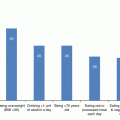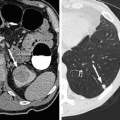Symptom
DOR (95% CI)
AUC
Sensitivity (95% CI)
1-specificity (95% CI)
LR+ (95% CI)
LR− (95% CI)
Rectal bleedinga
2.6 (1.9–3.6) p < 0.001
0.66
0.46 (0.38–0.55)
0.25 (0.19–0.31)
1.9 (1.5–2.3)
0.7 (0.6–0.8)
Blood mixed with stool
3.1 (2.0–4.8) p < 0.001
0.68
0.49 (0.30–0.69)
0.24 (0.13–0.40)
2.1 (1.5–2.8)
0.7 (0.5–0.9)
Blood: dark red
3.9 (1.7–9.2) P = 0.004
0.71
0.29 (0.09–0.65)
0.10 (0.03–0.28)
3.1 (1.6–6.0)
0.8 (0.6–1.1)
Change in bowel habit
1.5 (0.8–2.8) p = 0.16
0.57
0.32 (0.21–0.46)
0.24 (0.15–0.35)
1.4 (0.9–2.1)
0.9 (0.7–1.1)
Abdominal pain
0.7 (0.5–1.1) p = 0.12
0.45
0.19 (0.13–0.28)
0.24 (0.17–0.33)
0.8 (0.6–1.1)
1.1 (1.0–1.2)
Constipation
1.1 (0.8–1.5) p = 0.48
0.52
0.12 (0.08–0.18)
0.11 (0.07–0.16)
1.1 (0.8–1.5)
1.0 (1.0–1.0)
Diarrhoea
0.9 (0.4–1.7) p = 0.65
0.47
0.15 (0.07–0.28)
0.17 (0.09–0.29)
0.9 (0.5–1.6)
1.0 (0.9–1.1)
Weight loss
2.9 (1.6–5.0) p = 0.001
0.67
0.20 (0.12–0.31)
0.08 (0.05–0.13)
2.5 (1.5–4.0)
0.9 (0.8–1.0)
Our results for weight loss are similar to those reported in other systematic reviews, although the likelihood ratios reported by Ford (LR+ = 1.9; 95% CI 1.3–3.1, and LR− = 0.9; 95% CI 0.8–1.0) based on five studies [14], and Olde Bekkink (LR+ = 1.9; 95% CI 1.0–3.1) [6] were slightly lower than ours. Jellema reporting sensitivity = 0.2 and specificity = 0.89 [15].
Primary clinical study: Weight loss (unintentional) was associated with colorectal cancer. Patients who had lost more than 6 kg in weight were 3.2 times (95% CI 1.9–5.6) more likely to have cancer than those with no weight loss. 11.8% of people in our study had weight loss. Weight loss was more predictive for colorectal cancer in males than females.
2.6.2 Fatigue and Anaemia
Systematic review: we did not assess these in our systematic review. In their systematic review, Ford et al. [14] reported that the likelihood ratios were disappointing (LR+ = 1.38 (0.5–3.9), and LR− = 0.9 (0.7–1.1).
Primary clinical study: People with a history of anaemia were three times (OR 3.0; 95% CI 2.1–4.3) more likely to have colorectal cancer than those with no history. People with fatigue were 1.7 times (OR 1.7 95% CI 1.2–2.3) more likely to have colorectal cancer than those with no history of fatigue. Forty percent of people in the study complained of fatigue, and 10% said they had a history of anaemia.
Anaemia was more predictive of colorectal cancer if the person had up to two other symptoms, irrespective of what these were. It should be stressed that assessment of anaemia in our study was by self-reported recollection of the participants, not documented iron deficiency anaemia.
2.7 Characteristics of Symptoms: Frequency and Time Present
The risks associated with rectal bleeding, rectal mucus and abdominal pain depended on the length of time the symptom had been present and the frequency with which it occurred. For example, the colorectal cancer risk was the highest when the symptom occurred weekly and had been present for less than 12 months for patients with rectal bleeding (over 4 times higher: OR 4.3; 95% CI 2.9–6.3), rectal mucus (3.5 times higher: OR 3.5 95% CI 2.2–5.7), abdominal pain (2 times higher: OR 2.0; 95% CI 1.4–2.9), and incomplete evacuation (almost 2 times higher: OR 1.9; 95% CI 1.3–2.7). For change in bowel habit, short duration (<12 months) was associated with almost a two and a half times higher risk (OR 2.4; 95% CI 1.7–3.3). Notably, for each of these symptoms, the risk in those who had the symptom for longer than 12 months was similar to those without the symptom.
Gender was an effect modifier for colorectal cancer risk in patients with abdominal pain. Males with abdominal pain had a higher risk than males with no pain, while females were not at increased risk. However, when the duration of pain was taken into account, this gender effect was no longer significant: both males and females had a higher risk of colorectal cancer when pain occurred weekly and had been present for less than 12 months.
2.8 Summary of Findings: Summary of Findings on Single Symptoms
The symptoms usually considered important for colorectal cancer diagnosis are rectal bleeding, change in bowel habit, abdominal pain, weight loss, diarrhoea and constipation. Of these, in our systematic review only rectal bleeding and weight loss showed any association with cancer, although this association was small (Table 2.1). In our primary clinical study, only rectal bleeding and weight loss were associated with colorectal cancer, albeit with relatively low diagnostic value. Change in bowel habit and rectal mucus had slight associations with colorectal cancer. If these symptoms occurred more frequently and were present for less than 12 months, the association with colorectal cancer was higher. There was evidence that other symptoms were not associated with colorectal cancer.
2.9 Other Risk Predictors
In our primary clinical study, age was significantly associated with colorectal cancer, with the risk increasing with increasing age. Compared to people aged less than 50 years, people older than 70 years had an 8.6 times (OR 8.6; 95% CI 4.4–16.8) higher risk than colorectal cancer. Those aged between 60 and 69 had a 5.8 times (OR 5.8; 95% CI 2.9–11.5) higher risk, and those between 50 and 59 had a 3.8 times (OR 3.8; 95% CI 1.9–7.6) higher risk.
The increased incidence of colorectal cancer in higher age groups is well established. However, although not reflected in the findings of our study, it has recently become evident that colorectal cancer is becoming more common in people less than 50 years old [19, 20].
The number of symptoms a person reported was associated with a higher risk of colorectal cancer, with those reporting 5–11 symptoms having the highest risk. Smoking was also associated with a higher colorectal cancer risk.
Use of non-steroidal anti-inflammatory medications, having a higher level of education, being female or having had a colonoscopy within 10 years were all associated with lower risk of colorectal cancer. Almost 70% of cancers were in the 41% of people who had not had a colonoscopy in the previous 10 years.
A family history or personal history of polyps are accepted risk factors for an increased risk of colorectal cancer [21, 22]. In our study, these were associated with a lower risk of colorectal cancer. We postulate that in our study this was because many of these participants had had prior colonoscopy with removal of adenomas when present. The reasons for referral of patients in our study were heterogenous and included referral for symptoms evaluation, surveillance and screening.
We found no increased association with body mass index (BMI), use of aspirin, or a history of any other bowel disease, such as anal fissure, inflammatory bowel disease, haemorrhoids, previous bowel resection and diverticular disease.
2.10 Combination of Symptoms and Risk Factors
In a clinical setting, symptoms are seldom reviewed in isolation, and all available information is included in making a diagnosis and plan for further investigation and management. We therefore assessed all the symptoms and risk factors in a multivariate model and also assessed their incremental value.
The association noted for symptoms on their own was no longer evident for some symptoms when all symptoms and risk factors were taken into account together. Although family history of colorectal cancer, history of colorectal polyps, irritable bowel symptom syndrome all decreased the risk of cancer and smoking increased the risk when assessed individually, none of these remained significant risk factors in the multivariable risk model. This implies that these associations were not due directly to the factors themselves, but are in part explained by their association with other factors. The following factors were found to increase the risk of colorectal cancer in the multivariate model (Table 2.2): Rectal bleeding, rectal mucus, and abdominal pain—all occurring weekly and having been present for less than 12 months; increasing age, being male; and history of anaemia. Having had a colonoscopy in the previous 10 years, use of non-steroidal anti-inflammatory medication and aspirin, decreased the risk.
Table 2.2
The CRISP study: Symptoms, history and demographic variables—single and multivariable model
People with symptom | Cancer Prevalence (/100)a | OR: individual symptom (95% CI) | OR: individual symptom in multivariate modelb (95% CI) | ||
|---|---|---|---|---|---|
Number | Percent (%) (of all participants) | ||||
Rectal bleeding (all) | 3023 | 37.3 | 2.99 | 1.99 (1.45–2.73) | |
No bleeding | 5803 | 62.7 | 1.00 (referent) | ||
Present <12 months; occurring weekly | 689 | 8.40 | 6.18 | 4.27 (2.88–6.33) | 5.69 (3.65–8.87) |
Present <12 months; occurring occasionally | 1226 | 14.9 | 2.51 | 1.67 (1.08–2.57) | 2.06 (1.30–3.27) |
Present >12 months; occurring weekly | 356 | 4.3 | 1.79 | 1.18 (0.51–2.73) | >12 months: 1.50 (0.80–2.81) |
Present >12 months; occurring monthly/occasionally | 689 | 8.40 | 1.08 | 0.71 (0.33–1.55) | |
Change in bowel habit (all) | 3780 | 46.8 | 2.67 | 1.73 (1.25–2.38) | |
No change in bowel habit | 4303 | 53.2 | 1.56 | 1.00 (referent) | |
Present <12 months | 2338 | 28.5 | 3.52 | 2.30 (1.64–3.21) | |
Present >12 months | 1365 | 16.6 | 1.30 | 0.83 (0.49–1.43) | |
Rectal mucus (all) | 1318 | 16.2 | 2.76 | 1.46 (1.00–2.14) | |
No rectal mucus | 6809 | 83.8 | 1.91 | 1.00 (referent) | |
Present <12 months; occurring weekly | 328 | 3.4 | 6.39 | 3.51 (2.16–5.72) | 3.19 (1.82–5.59) |
Present <12 months; occurring occasionally | 393 | 4.8 | 2.38 | 1.25 (0.63–2.49) | 1.30 (0.62–2.71) |
Present >12 months; occurring weekly | 201 | 2.5 | 0.51 | 0.26 (0.04–1.89) | >12 months: 1.25 (0.49–3.21) |
Present >12 months; occurring monthly/occasionally | 265 | 3.2 | 1.57 | 0.82 (0.30–2.24) | |
Abdominal pain | 3905 | 48.0 | 2.19 | ||
No abdominal pain | 1.00 (referent) | ||||
Present <12 months; occurring weekly | 1522 | 18.6 | 3.82 | 2.02 (1.42–2.86) | 2.16 (1.48–3.15) |
Present <12 months; occurring occasionally | 787 | 9.6 | 1.88 | 0.97 (0.55–1.73) | 1.05 (0.57–1.93) |
Present >12 months; occurring weekly | 956 | 11.6 | 0.87 | 0.45 (0.21–0.93) | (>12 months): 1.12 (0.25–4.92) |
Present >12 months; occurring monthly/occasionally | 560 | 6.8 | 0.37 | 0.19 (0.05–0.78) | |
Incomplete evacuation | 3724 | 46.2 | 2.26 | 1.20 (0.87–1.64) | |
No incomplete evacuation | 4365 | 53.8 | 1.89 | 1.00 (referent) | |
Present <12 months; occurring weekly | 1393 | 17.0 | 3.47 | 1.86 (1.29–2.70) | |
Present <12 months; occurring occasionally | 630 | 7.7 | 1.51 | 0.79 (0.55–1.73) | |
Present >12 months; occurring weekly | 860 | 10.5 | 1.20
Stay updated, free articles. Join our Telegram channel
Full access? Get Clinical Tree
 Get Clinical Tree app for offline access
Get Clinical Tree app for offline access

| ||



